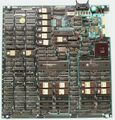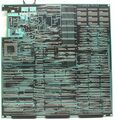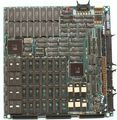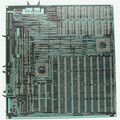Difference between revisions of "Sega OutRun hardware"
From Sega Retro
| Line 65: | Line 65: | ||
** Sprite/Texture sizes: 8×8 to 512×256 [[texel]]s | ** Sprite/Texture sizes: 8×8 to 512×256 [[texel]]s | ||
** Framebuffer [[fillrate]]: 23.076923 [[Pixel|MPixels/s]] (double buffering, 92.307692 MB/s) | ** Framebuffer [[fillrate]]: 23.076923 [[Pixel|MPixels/s]] (double buffering, 92.307692 MB/s) | ||
| − | ** Texels per frame: 769,230 texels (30 FPS) to 384,267 texels (60.0543 FPS), 1466 texels per scanline | + | ** Texels per frame: 769,230 texels (30 FPS) to 384,267 texels (60.0543 FPS), 1466 texels per scanline, 128 sprites per scanline |
* [[wikipedia:Tile engine|Tilemap]] planes: 2 tilemap layers, [[Sega System 16|System 16B]] tilemap system, [[wikia:w:c:gaming:Parallax scrolling|row/column scrolling]], parallax scrolling{{ref|[https://github.com/mamedev/mame/blob/master/src/mame/drivers/segaorun.cpp Sega OutRun Hardware (MAME)]}}{{intref|Sega System 16B hardware notes (2003-01-12)}} | * [[wikipedia:Tile engine|Tilemap]] planes: 2 tilemap layers, [[Sega System 16|System 16B]] tilemap system, [[wikia:w:c:gaming:Parallax scrolling|row/column scrolling]], parallax scrolling{{ref|[https://github.com/mamedev/mame/blob/master/src/mame/drivers/segaorun.cpp Sega OutRun Hardware (MAME)]}}{{intref|Sega System 16B hardware notes (2003-01-12)}} | ||
** Tilemap resolution: 512×256 (1024×512 virtual resolution) | ** Tilemap resolution: 512×256 (1024×512 virtual resolution) | ||
Revision as of 11:41, 3 October 2016
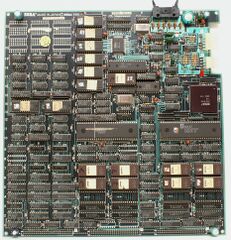
| |||||
| Sega OutRun hardware | |||||
|---|---|---|---|---|---|
| Manufacturer: Sega | |||||
|
Sega's OutRun hardware was released in 1986 with the driving game OutRun. It is a successor to their Hang-On hardware, making it the second in Sega's Super Scaler series of three-dimensional arcade hardware. It was succeeded by the Sega X Board in 1987.
The OutRun hardware, like the Hang-On hardware, has specifications similar to those of the System 16, with the addition of a second 68000 processor and a separate video board which allowed for an extra graphics layer for the road as well as sprite/texture scaling capabilities. The OutRun hardware can do everything the Hang-On hardware can do, but its processors are clocked higher (allowing for quicker calculations), it has more memory and faster bandwidth, and the video board's capabilities have been expanded, capable of drawing two roads (the Hang-On hardware can only draw one) and rendering sprites/textures using a framebuffer system with a higher fillrate (the Hang-On hardware used a line-buffer system). At the time, the OutRun hardware was a very powerful but expensive arcade board, with arcade operators advised to charge twice as many credits than for regular arcade machines.
Three games made use of the hardware, all of which are driving games. However, only OutRun and Turbo OutRun are truly for this hardware, as Super Hang-On was also released for the Hang-On hardware in a mostly identical form.
Contents
Technical Specifications
Sega OutRun
- Board composition: CPU Board (Main Board), Video Board[1]
- Main CPU: 2× 68000 @ 12.5 MHz: 16/32‑bit instructions, 4.375 MIPS, 32‑bit (2× 16‑bit) data bus, 44‑bit (24‑bit, 20‑bit) address bus[2]
- Memory Mapper FPGA: Sega 315‑5195 Memory Mapper @ 40 MHz: 16‑bit data bus, 24‑bit address bus[3][2]
Sound
- Sound CPU: Zilog Z80 @ 4 MHz (8/16‑bit instructions, 0.58 MIPS)
- Sound chips: 2 chips, 24 channels, 24‑bit bus width[4]
- FM synthesis chip: Yamaha YM2151 @ 4 MHz (8 FM channels, 8‑bit bus width)[5]
- PCM sampling chip: SegaPCM 315‑5218 Sound Controller @ 4/16 MHz[1] (stereo output, 16 PCM channels, 12‑bit audio depth,[6] 31.25 kHz sampling rate, 16‑bit bus width)
- Sound DAC: Yamaha YM3012 @ 4 MHz: 16‑bit floating‑point dynamic range[7]
- Sound FPGA: Sega 315‑5223A (Signetics CK2605) @ 16 MHz: 8‑bit bus width[8][9]
Graphics
- Video Board GPU: Sega 171‑5377 VIDEO Board graphics chipset @ 25.1748 MHz: 6 processors, 80‑bit RAM (167.521366 MB/s), 64‑bit ROM (37 MB/s)[1][3][4]
- 315‑5197 Sega Custom Tilemap Generator FPGA: 16‑bit RAM (15.384615 MHz, 65 ns, 30.76923 MB/s), 24‑bit ROM (4 MHz, 250 ns, 12 MB/s)
- 315‑5211 Sega Custom Sprite Generator FPGA: 16‑bit sprite attribute RAM (22.222222 MHz, 45 ns, 44.444444 MB/s),[10] 48‑bit sprite framebuffer RAM (15.384615 MHz, 65 ns, 92.307692 MB/s),[11] 32‑bit ROM (5 MHz, 200 ns, 20 MB/s)[12]
- 315‑5227A Signetics CK2678 PAL: 8‑bit ROM (5 MHz, 200 ns, 5 MB/s)[12]
- 315‑5228 Signetics CK2605 FPGA: 8‑bit[8][9]
- 315‑5242 Sega Custom Color Encoder: 16‑bit
- 8255‑2 NEC µPD8255AC‑2: 24‑bit (3× 8‑bit) PPI (Programmable Peripheral Interface)[13]
- Main Board GPU: Sega 171‑5376 CPU Board graphics chipset @ 39.99967 MHz: 6 processors, 5‑bit RAM (6.25 MB/s), 16‑bit ROM (10 MB/s)[3][1][14]
- 2× 315‑5155 Sega Road Bit Extraction PAL: 16‑bit (2× 8‑bit), 2× 5 MHz ROM (200 ns, 10 MB/s)[12]
- 315‑5222 Signetics PLS153N Road Mixing FPGA: 8‑bit internal (33.333333 MHz),[15] 5‑bit RAM (10 MHz, 100 ns, 6.25 MB/s)
- 315‑5223A Signetics CK2605 FPGA: 8‑bit internal,[8][9] 4‑bit external
- 2× MMI PAL16R4 (315‑5225, 315‑5226) PAL: 16‑bit (2× 8‑bit)[16]
- Fixed-point arithmetic capabilities: Z-buffering, depth map[17]
- Video resolution: 320×224 (display), 400×262 (overscan),[1] progressive scan
- Scanlines: 224 (display), 262 (overscan)
- Refresh rate: 60.0543 Hz (V‑sync)[1]
- Frame rate: 30–60.0543 FPS
- Color palette: 98,304
- 16-bit color palette: 15‑bit RGB color depth (32,768 colors), 1‑bit shadow & highlight triples up to 98,304 colors
- Colors on screen: 12,288[1]
- Graphical planes:
- 2 tilemap layers
- 1 text layer
- 1 sprite layer
- 1 road layer
- Translucent shadows
- Video clock rate: 25.1748 MHz (60.0543 Hz refresh rate)
- Sprite plane: Sprite/Texture framebuffer, hardware sprite-scaling/zooming, 128 on‑screen sprites per frame, 7680 sprites/textures scaled per second, 16 colors (4‑bit) per sprite/texture
- Framebuffer: 512×256 resolution, double buffering,[6] 16-bit color depth
- Sprite/Texture sizes: 8×8 to 512×256 texels
- Framebuffer fillrate: 23.076923 MPixels/s (double buffering, 92.307692 MB/s)
- Texels per frame: 769,230 texels (30 FPS) to 384,267 texels (60.0543 FPS), 1466 texels per scanline, 128 sprites per scanline
- Tilemap planes: 2 tilemap layers, System 16B tilemap system, row/column scrolling, parallax scrolling[1][18]
- Tilemap resolution: 512×256 (1024×512 virtual resolution)
- Colors per tile: 8 colors (3‑bit)
- Tile size: 8×8 pixels (24 bytes)
- Tile fillrate: 15.384615 MPixels/s, 240,384 tiles/sec (5.769231 MB/s)
- Tiles per frame: 4002 tiles and 256,178 texels (60.0543 FPS) to 8012 tiles and 512,820 texels (30 FPS)
- Tiles per scanline: 978 texels, 122 tiles
- Road plane: Can draw 2 roads at once, bitmap/texture, 512×256 resolution per road[17]
- Colors per pixel: 8 colors (3‑bit)
- Road fillrate: 1024 texels per scanline, 268,288 texels per frame, 16.111848 MPixels/s (6.041943 MB/s)
Memory
Bandwidth
Turbo OutRun
The Turbo OutRun hardware is largely identical, but with the following changes:[23]
Graphics
- Video Board GPU: Sega 171‑5377 VIDEO Board graphics chipset @ 25.1748 MHz: 6 processors, 80‑bit RAM (189.898989 MB/s)
- Main Board GPU: Sega 171‑5376 CPU Board graphics chipset @ 39.99967 MHz: 6 processors, 5‑bit RAM (6.25 MB/s)
- Sprite plane:
Bandwidth
- RAM bandwidth:
- VRAM: 196.148989 MB/s (85‑bit)
Gallery
List of Games
- Out Run (1986)
- Super Hang-On (1987)
- Turbo OutRun (1989)
- Limited Edition Hang-On (1991)
References
- ↑ 1.0 1.1 1.2 1.3 1.4 1.5 1.6 1.7 1.8 1.9 Sega OutRun Hardware (MAME)
- ↑ 2.0 2.1 File:OutRun Schematics.pdf, page 2
- ↑ 3.0 3.1 3.2 Sega 16‑Bit Common Hardware, MAME
- ↑ 4.0 4.1 4.2 File:OutRun Schematics.pdf, page 8
- ↑ File:YM2151 datasheet.pdf
- ↑ 6.0 6.1 6.2 Sega "X-Board" hardware notes (2004-12-03)
- ↑ File:YM3012 datasheet.pdf
- ↑ 8.0 8.1 8.2 File:303A-011A Device List.pdf, page 11
- ↑ 9.0 9.1 9.2 File:CK2605 Fusemap.pdf
- ↑ 10.0 10.1 10.2 10.3 10.4 File:TMM2018 datasheet.pdf
- ↑ 11.0 11.1 11.2 11.3 11.4 File:HM65256B datasheet.pdf
- ↑ 12.0 12.1 12.2 12.3 File:M27256 datasheet.pdf
- ↑ File:UPD8255A datasheet.pdf
- ↑ File:OutRun Schematics.pdf, page 5
- ↑ File:PLS153 datasheet.pdf
- ↑ File:PAL16R datasheet.pdf
- ↑ 17.0 17.1 Lou's Pseudo 3D Page
- ↑ Sega System 16B hardware notes (2003-01-12)
- ↑ 19.0 19.1 19.2 File:OutRun Schematics.pdf
- ↑ File:TMM2063P datasheet.pdf
- ↑ File:TurboOutRun Arcade JP Flyer.pdf, page 2
- ↑ Turbo OutRun (MAME)
- ↑ Inside Manufactured Products: Sega's Turbo OutRun Arcade Machine
| Sega arcade boards |
|---|
| Originating in arcades |
|
77
78
79
80
81
82
83
84
85
86
87
88
89
90
91
92
93
94
95
96
97
98
99
|
| Console-based hardware |
|
84
85
86
87
88
89
90
91
92
93
94
95
96
97
98
99
00
01
02
03
04
05
06
07
08
09
10
11
12
13
14
|
| PC-based hardware |
|
05
06
07
08
09
10
11
12
13
14
15
16
17
18
19
20
21
22
23
|
